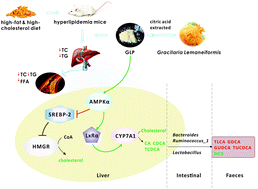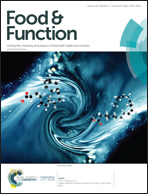A sulfated polysaccharide from Gracilaria Lemaneiformis regulates cholesterol and bile acid metabolism in high-fat diet mice†
Abstract
This study aimed to evaluate the regulation of lipid metabolism and mechanism of a sulfated polysaccharide from Gracilaria Lemaneiformis (GLP). The results showed that GLP significantly decreased the hepatic total cholesterol (TC) and triglyceride (TG) levels in the serum of high-fat diet mice and prevented body weight gain and alleviated the accumulation of fat. Furthermore, GLP may accelerate the conversion of cholesterol to bile acids by promoting the expression of LxRα and CYP7A1 genes and regulating the relative abundance of Bacteroides, Ruminococcus_1 and Lactobacillus. Pearson's correlation analysis showed that the relative abundance of Alistipes, Prevotellaceae_UCG-001, and Corprococcus_1 was negatively associated with the hydrophobic BAs CDCA and DCA levels, while the relative abundance of Lachnospiraceae_NK4A136_group and Roseburia was positively correlated with the hydrophilic BAs UDCA and TUDCA levels. This study suggests that GLP can be used as a functional food for regulating cholesterol metabolism.



 Please wait while we load your content...
Please wait while we load your content...